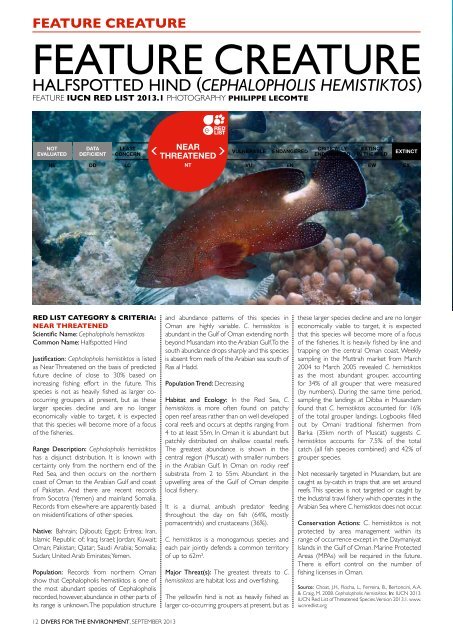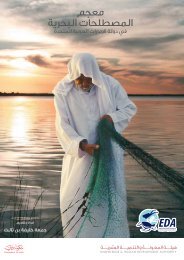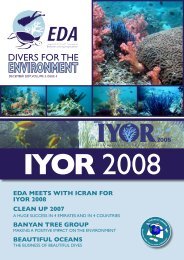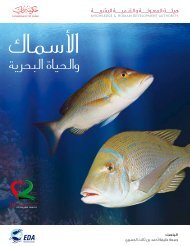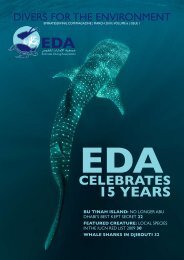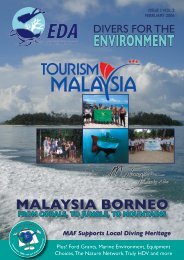Download - Emirates Diving Association
Download - Emirates Diving Association
Download - Emirates Diving Association
You also want an ePaper? Increase the reach of your titles
YUMPU automatically turns print PDFs into web optimized ePapers that Google loves.
FEATURE CREATURE<br />
FEATURE CREATURE<br />
HALFSPOTTED HIND ( CEPHALOPHOLIS HEMISTIKTOS)<br />
FEATURE IUCN RED LIST 2013.1 PHOTOGRAPHY PHILIPPE LECOMTE<br />
STRANDED: SOUTHERN CALIFORNIA SEA LION PUPS<br />
Feature Brianne Billups, Reef Check California SoCial Volunteer Coordinator<br />
Photography Claire Fackler/NOAA National Marine Sanctuaries<br />
Red List Category & Criteria:<br />
NEAR THREATENED<br />
Scientific Name: Cephalopholis hemistiktos<br />
Common Name: Halfspotted Hind<br />
Justification: Cephalopholis hemistiktos is listed<br />
as Near Threatened on the basis of predicted<br />
future decline of close to 30% based on<br />
increasing fishing effort in the future. This<br />
species is not as heavily fished as larger cooccurring<br />
groupers at present, but as these<br />
larger species decline and are no longer<br />
economically viable to target, it is expected<br />
that this species will become more of a focus<br />
of the fisheries.<br />
Range Description: Cephalopholis hemistiktos<br />
has a disjunct distribution. It is known with<br />
certainty only from the northern end of the<br />
Red Sea, and then occurs on the northern<br />
coast of Oman to the Arabian Gulf and coast<br />
of Pakistan. And there are recent records<br />
from Socotra (Yemen) and mainland Somalia.<br />
Records from elsewhere are apparently based<br />
on misidentifications of other species.<br />
Native: Bahrain; Djibouti; Egypt; Eritrea; Iran,<br />
Islamic Republic of; Iraq; Israel; Jordan; Kuwait;<br />
Oman; Pakistan; Qatar; Saudi Arabia; Somalia;<br />
Sudan; United Arab <strong>Emirates</strong>; Yemen.<br />
Population: Records from northern Oman<br />
show that Cephalopholis hemistiktos is one of<br />
the most abundant species of Cephalopholis<br />
recorded, however, abundance in other parts of<br />
its range is unknown. The population structure<br />
and abundance patterns of this species in<br />
Oman are highly variable. C. hemistiktos is<br />
abundant in the Gulf of Oman extending north<br />
beyond Musandam into the Arabian Gulf. To the<br />
south abundance drops sharply and this species<br />
is absent from reefs of the Arabian sea south of<br />
Ras al Hadd.<br />
Population Trend: Decreasing<br />
Habitat and Ecology: In the Red Sea, C.<br />
hemistiktos is more often found on patchy<br />
open reef areas rather than on well developed<br />
coral reefs and occurs at depths ranging from<br />
4 to at least 55m. In Oman it is abundant but<br />
patchily distributed on shallow coastal reefs.<br />
The greatest abundance is shown in the<br />
central region (Muscat) with smaller numbers<br />
in the Arabian Gulf. In Oman on rocky reef<br />
substrata from 2 to 55m. Abundant in the<br />
upwelling area of the Gulf of Oman despite<br />
local fishery.<br />
It is a diurnal, ambush predator feeding<br />
throughout the day on fish (64%, mostly<br />
pomacentrids) and crustaceans (36%).<br />
C. hemistiktos is a monogamous species and<br />
each pair jointly defends a common territory<br />
of up to 62m².<br />
Major Threat(s): The greatest threats to C.<br />
hemistiktos are habitat loss and overfishing.<br />
The yellowfin hind is not as heavily fished as<br />
larger co-occurring groupers at present, but as<br />
these larger species decline and are no longer<br />
economically viable to target, it is expected<br />
that this species will become more of a focus<br />
of the fisheries. It is heavily fished by line and<br />
trapping on the central Oman coast. Weekly<br />
sampling in the Muttrah market from March<br />
2004 to March 2005 revealed C. hemistiktos<br />
as the most abundant grouper, accounting<br />
for 34% of all grouper that were measured<br />
(by numbers). During the same time period,<br />
sampling the landings at Dibba in Musandam<br />
found that C. hemistiktos accounted for 16%<br />
of the total grouper landings. Logbooks filled<br />
out by Omani traditional fishermen from<br />
Barka (35km north of Muscat) suggests C.<br />
hemistiktos accounts for 7.5% of the total<br />
catch (all fish species combined) and 42% of<br />
grouper species.<br />
Not necessarily targeted in Musandam, but are<br />
caught as by-catch in traps that are set around<br />
reefs. This species is not targeted or caught by<br />
the Industrial trawl fishery which operates in the<br />
Arabian Sea where C. hemistiktos does not occur.<br />
Conservation Actions: C. hemistiktos is not<br />
protected by area management within its<br />
range of occurrence except in the Daymaniyat<br />
Islands in the Gulf of Oman. Marine Protected<br />
Areas (MPAs) will be required in the future.<br />
There is effort control on the number of<br />
fishing licenses in Oman.<br />
Source: Choat, J.H., Rocha, L., Ferreira, B., Bertoncini, A.A.<br />
& Craig, M. 2008. Cephalopholis hemistiktos. In: IUCN 2013.<br />
IUCN Red List of Threatened Species. Version 2013.1. www.<br />
iucnredlist.org<br />
A rare event is currently taking place along<br />
the Southern California coast. Since January<br />
of this year, more than 1,300 malnourished<br />
sea lion pups have come ashore in the area<br />
spanning from Santa Barbara to San Diego.<br />
Marine mammal rescue centers have been<br />
overwhelmed by the extraordinarily high<br />
numbers of sea lions coming into their facilities.<br />
This has led the National Oceanographic and<br />
Atmospheric Administration (NOAA) to<br />
declare an “unusual mortality event”.<br />
The stranded sea lion pups were born last<br />
summer and it is abnormal to see them on<br />
coastal beaches now, considering they should<br />
be with their mothers at the Channel Islands.<br />
Sea lions born during that time typically don’t<br />
wean until April or May. In general, they are<br />
turning up alive but severely emaciated, some<br />
weighing less than 20 pounds when they<br />
should be well over 50 pounds at this point in<br />
their development, marine officials say.<br />
Due to the fact that almost all of the stranded<br />
pups are extremely underweight, scientists<br />
believe the mass stranding is occurring since<br />
they are not getting enough food. Environmental<br />
conditions in the area are being studied for<br />
clues as to why the pups are starving. Scientists<br />
are focusing their investigation on factors such<br />
as changes in algae growth, wind patterns and<br />
sea surface temperature, which have led to sea<br />
lion stranding epidemics during years past.<br />
The leading hypothesis is that particular sea<br />
conditions are cutting the sea lion pups’ main<br />
food supply of anchovies and sardines. While<br />
adult sea lions and other marine mammals are<br />
more adaptable and can change their feeding<br />
habits in the face of a shortage, pups are more<br />
limited in how far they can travel for food and<br />
what they can eat. As part of their investigation,<br />
scientists are also testing blood and tissue<br />
samples for bacterial, viral and other infectious<br />
agents as well as traces of radioactivity.<br />
While the exact cause of the high numbers<br />
of sea lion strandings is still to be determined,<br />
scientists are working diligently to pinpoint a<br />
reason. In the meantime, rescue centers are<br />
working at their maximum capacity to release<br />
rehabilitated pups back into the wild.<br />
12 DIVERS FOR THE ENVIRONMENT, SEPTEMBER 2013<br />
SEPTEMBER 2013, DIVERS FOR THE ENVIRONMENT 13


